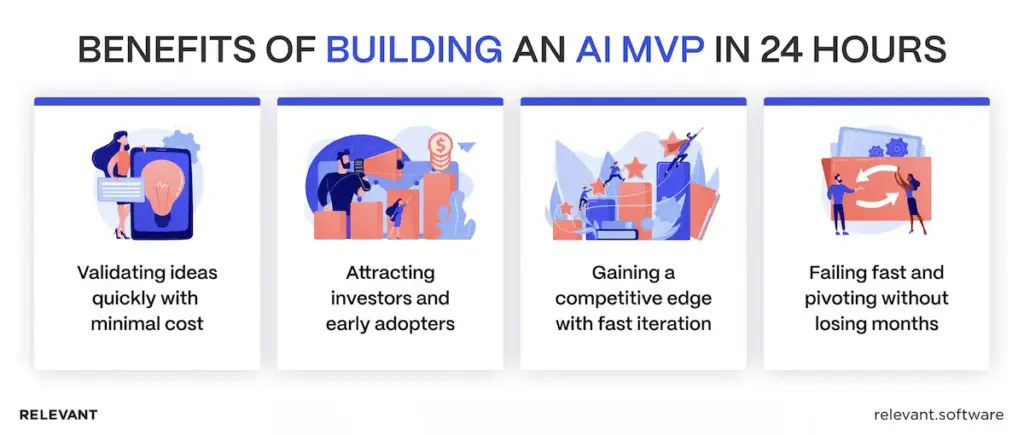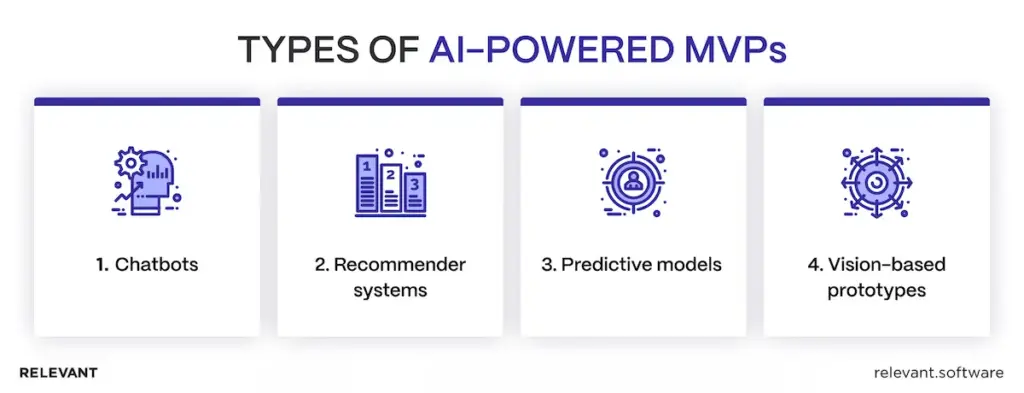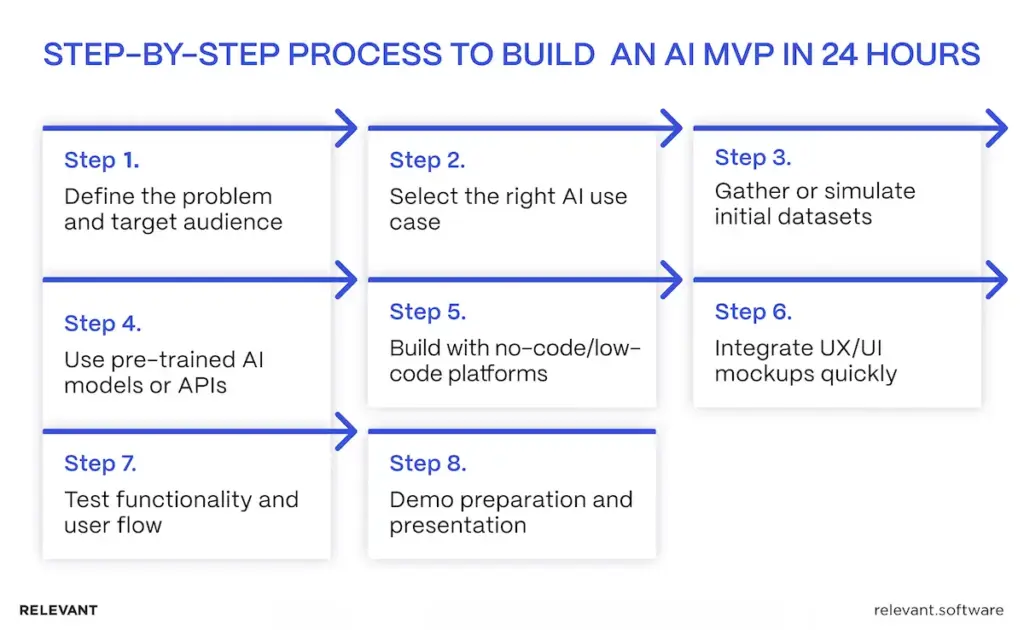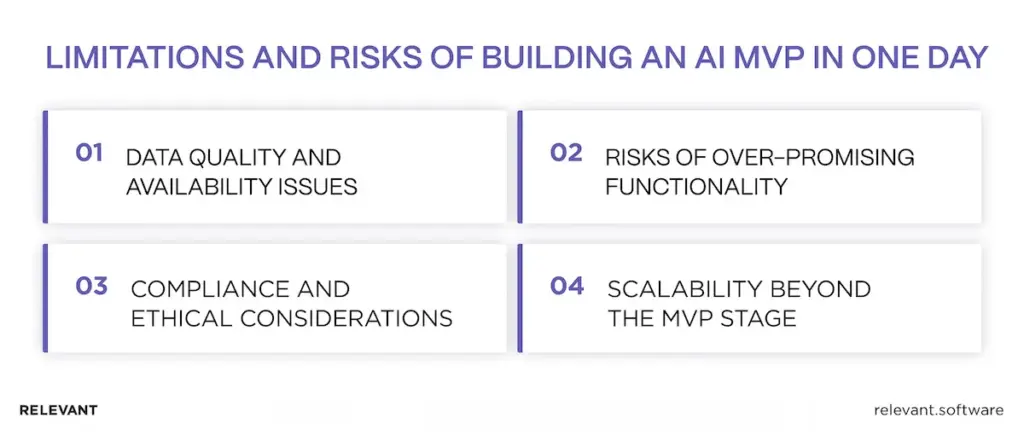Inside the Process: Building a Working MVP with AI in One Day

Building a test version of your product in just one day might sound bold — but with AI and no-code tools, it’s now entirely possible. This approach lets you build an MVP fast, test real demand, and accelerate funding discussions. For founders, product leaders, innovation officers, and investors, building an AI-powered MVP in 24 hours turns ideas into proof and speeds up the road to market.
This article breaks down what an AI-powered MVP is, why speed matters when testing an idea, and how to plan a focused hour-by-hour build that turns a concept into a working demo. You will see which tools to use, how to control risk, and when it pays to involve expert help. We also address real-world limits and clarify where Relevant Software fits as a partner for rapid prototyping, AI development services, and the transition from first demo to full-scale growth.
What is an AI-powered MVP?
Traditionally, an MVP is the simplest version of a product that lets you validate a business idea, attract early adopters, and gather feedback before investing heavily in full development.
When you apply AI to the structure of that MVP, you shift several variables: you can embed intelligence (e.g., predictive insights, automation, personalization) into the product, accelerate iteration, and potentially offer differentiated value from day one. An “AI MVP” (or “MVP AI”) is not just a user interface plus basic logic. It includes a model or AI workflow that enhances the product’s core capability.
Key differences between a regular MVP and an AI-powered MVP
If you ask how to build a minimum viable product, the main idea stays the same: build fast, test early, learn quickly. When artificial intelligence enters the process, both “minimum” and “viable” change because AI shifts attention from shipping features to proving intelligent value.
- Feature focus vs. learning focus. A regular MVP shows that basic features work. An AI-powered MVP tests whether intelligence truly adds value. The question moves from “Can users finish this task?” to “Can the model predict or automate something that matters?”
- Data and model readiness. In a standard build, teams focus on interface and user flow. In an AI MVP, data quality and model performance become part of the product. You must confirm access to reliable data, choose or train suitable models, and validate their accuracy and fairness before scaling.
- Speed and tooling. Modern MVP tools, such as pre-trained models, hosted APIs, and low-code platforms, help teams move from concept to demo in hours rather than weeks. Smart automation also lowers the cost to build an MVP by cutting manual work and rework.
- Risk profile. AI adds specific risks, including weak data, bias, and unpredictable performance. Early validation ensures the intelligence works reliably and ethically before more investment.
- Value proposition. An AI-powered MVP often delivers a clear step up in value—faster decisions, automated personalization, or real-time insights — that attracts early adopters and investors sooner than traditional prototypes.
- Bridge to planning. If you need clarity on how long to build an MVP, start with a focused scope, pick the right tools, and validate data early.
In the next section, we explore the benefits of building an AI MVP in a day timeframe.
Benefits of building an AI MVP in 24 hours
Launching a functional product in a day might seem extreme, but the advantages are compelling for the target audience (startup founders, innovation leaders, product managers, investors).

1. Validating ideas quickly with minimal cost
By building your MVP in 24 hours, you avoid months of development time and high costs before you know whether your idea works. You test assumptions fast: does the core AI capability solve a specific problem, and does it address the core problem users feel today with essential features and key features rather than extras?
With a lean build, you reduce time to the first version in the market and start gathering user feedback, observing user behavior, and capturing technical metrics without writing more than a single line of code beyond what proves value. Data collection stays purposeful: start with pragmatic data sources, build simple data pipelines, use synthetic data where needed, and track model accuracy early rather than guessing. This aligns with the aim of a minimum viable product: learn from real feedback with the least effort.
2. Attracting investors and early adopters
Even a rough prototype is more convincing than a pitch. It demonstrates real progress. Investors look for proof of capability, speed, and execution — not just vision. A launchable MVP built with AI under tight deadlines proves your team can deliver, your tech stack fits the problem, and your process produces measurable results. Startups using an MVP model report up to a 60% lower failure rate and a 35% faster time-to-market compared to traditional builds. Early users also want something they can try — releasing fast helps you gather feedback, build buzz, and earn credibility.
3. Gaining a competitive edge with fast iteration
In sectors where speed matters, such as SaaS, fintech, healthtech, and marketplaces, being first with an AI solution can separate market entry from noise. A 24-hour build keeps you ahead of slower competitors and encourages an iterative approach that tightens the feedback loop. You can refine core features based on actual user feedback, expand key features that improve user engagement, and pause features that do not move technical metrics. This rhythm helps manage technical debt, shortens development time, and keeps the product close to real user needs.
4. Failing fast and pivoting without losing months
Not every idea succeeds, but a quick AI MVP helps you fail smart. It keeps technical debt low and frees up resources for the next iteration. Start with synthetic data if real datasets aren’t available, then swap it out later. Record every assumption that impacts accuracy or privacy. If the AI doesn’t deliver value, you’ve lost a day, not half a year, and gained insights on demand, channel fit, and what truly moved the project forward.
Once you have validated why speed matters, the next step is choosing how to express the idea in AI form. The type of MVP you build defines scope and learning, sets expectations for data pipelines and tech stack choices, and guides which essential features prove value first.
Types of AI-powered MVPs
AI MVPs vary widely, but they all share one goal: demonstrating how artificial intelligence adds measurable value to a workflow or user experience. Below are four common types that can be built quickly, often within 24–48 hours, using pre-trained models and ready-made APIs.

1. Chatbots
Chatbots are the simplest entry point into AI MVPs. Powered by APIs like OpenAI, Azure Bot Service, or Dialogflow, they respond to user queries in natural language. They fit customer support, onboarding, and knowledge base automation. In a 24-hour build, you can connect a model to a domain dataset, define tone and context, and test user satisfaction within real conversations. The quick setup and measurable engagement make chatbots ideal for proof-of-concept validation.
2. Recommender systems
Even with a small dataset, you can build a recommendation engine that feels intelligent. By combining basic user profiles with collaborative or content-based filtering, your MVP can suggest items, articles, or partners. Platforms like TensorFlow Lite or Amazon Personalize speed the process with built-in logic. These prototypes help founders demonstrate personalization value, often one of the strongest hooks for investors.
3. Predictive models
Predictive MVPs use AI to forecast outcomes like churn, demand, or pricing. They’re usually powered by tabular data from open sources or synthetic datasets. With pre-trained models from platforms like Hugging Face or Google Vertex AI, you can skip long training cycles and connect data through simple APIs. In just a few hours, you can visualize predictions, test accuracy, and demonstrate how AI-driven insights lead to smarter decisions.
4. Vision-based prototypes
If your idea involves images, documents, or real-world detection, vision APIs from AWS, Google, or Azure make it achievable in a day. These services handle heavy model lifting for object detection, document parsing, or defect identification. Your MVP might scan an invoice and extract key data, or recognize product quality from photos. Even a small proof like this helps you show investors and users that the idea has operational potential.
Now that you know what kind of AI MVP you’re creating, let’s translate that decision into action. The next section breaks down a focused one-day process that takes you from problem statement to functional demo — proof that your idea can work in the real world.
Can you really build an MVP in 24 hours?
Good question — and the honest answer is: yes, but with limits. Success depends on a sharp scope and strict focus on the word “minimum.” The aim is to prove the core idea fast, not to finish a full product. Below you will find what a team can deliver in one day, what it cannot, and how to treat this format so it gives real value.
What a team can do in 24 hours
The goal is to show core value, not a full product. In one day, a team can make a simple prototype that:
- shows the main benefit and the problem it solves
- uses AI or no-code tools to run the main flow
- collects first feedback or basic usage data
- helps you pitch the idea to investors or a leadership team
This one-day version can include:
- a clickable interface in Framer, Webflow, or Figma
- simple automations through Zapier, n8n, or Make
- an AI feature via OpenAI, Anthropic, or Hugging Face APIs
- a small data store in Airtable, Google Sheets, or Firebase
You end the day with something that works, looks real, and proves the concept.
What’s not realistic in 24 hours
Keeping expectations grounded matters. Within a single day, a team will not produce:
- A production-ready, fully tested product
- Advanced layers of security, scalability, or compliance
- Complex integrations or mature multi-user logic
- A complete QA process and deployment pipeline
These steps come later, once the concept shows enough promise to justify deeper investment.
What “building an MVP in 24 hours” really means
The goal is not finishing a product but getting a market signal fast. You build your MVP just enough to:
- Test a specific hypothesis
- Capture genuine user reactions or usage data
- Make a clear decision to move forward, refine, or pivot
When understood this way, a 24-hour MVP becomes a smart, focused experiment that validates ideas before full development begins.
Step-by-step process to build an AI MVP in 24 hours
You have one day, a sharp idea, and the pressure to show real value. Here is where Relevant Software expertise turns urgency into a calm, workable plan for AI transforming software development. We start by naming one measurable outcome and the single AI capability that proves it, then map a path that moves from problem statement to a live demo without waste.
Each stage leaves you with something concrete a user can try, from a small dataset and a reliable model call to a clean screen and a short walkthrough. Use this plan to develop an MVP in one day when you need proof, not polish.

Define the problem and target audience
We start by writing one short, simple sentence that explains:
- Who the user is,
- When they face the problem, and
- What result do we want to achieve?
Then we add one clear way to measure success.
Example:
“Support managers cut average password reset time by 20% this week.”
If everyone on the team can say this goal from memory, it means the idea is focused enough to start building right away.
Select the right AI use case
Relevant Software developers see faster wins when the capability matches the job. NLP fits support, search, and summarization. Computer vision fits document capture and defect detection. Predictive analytics fits scoring and forecasts. Our experts typically use a stable API that shows value on one screen, so the demo lands quickly.
Gather or simulate initial datasets
Our data team collects a small, focused dataset, usually 10 to 50 examples that reflect real use. Each field is clear, simple, and directly tied to the problem we’re solving. If real data isn’t available yet, we create synthetic samples that follow the same structure. We document all labels and limits from the start so that early accuracy checks stay transparent and reliable.
Use pre-trained AI models or APIs
Our engineers choose one AI provider for the day, such as OpenAI, Hugging Face, Google Vertex AI, or Azure AI, to stay focused and avoid switching tools. They use the platform’s SDK (a ready-made developer toolkit) to connect the model, send data, and track how it responds. We set up a backup model in case something fails during the demo. All prompts and settings are saved in one file, so updates are easy to review, test, and fine-tune.
Build with no-code/low-code platforms
Founders who want to build MVP without code move fastest with this step. Relevant Software typically uses Bubble or Retool for CRUD and dashboards, and Streamlit for data and model demos. The goal: one clean template, one API call, one screen, one clear next step. Add basic authentication, simple logs, and a feedback button. This keeps costs low while showing real, visible value to users and investors.
Integrate UX/UI mockups quickly
Our team uses a custom AI-driven design workflow built at Relevant Software to speed up prototyping and idea validation. Using tools like Gemini, Liner, Perplexity, and Claude, the process speeds up requirement gathering and concept creation. Then teams switch to v0 and Cursor for front-end prototyping, with Figma MCP used for complex interfaces. This setup has already shortened design validation cycles and boosted creative output.
Test functionality and user flow
Our team runs through the main user journey several times to make sure everything works smoothly. Then we intentionally trigger an error to confirm that the app shows a clear, helpful message. We invite one or two early users to test the flow while we observe. Any confusion they face turns into instant fixes. A few real examples of inputs and outputs are added to the demo kit to make the presentation authentic and practical.
Demo preparation and presentation
Our team at Relevant Software helps refine the story so it’s clear, focused, and persuasive. We record a short two-minute walkthrough that shows three things: the input, the AI process, and the result. We end with one key metric and the next decision point — a simple structure that keeps momentum high and sets expectations for pilot projects and investor reviews.
Final note: make decisions as soon as you receive feedback. If users see value, keep the flow. If quality drops, refine the model. If signals shift, narrow the use case. Speed only matters when every day ends with a clearer direction and a stronger product.
Hour-by-hour build schedule
Here’s a typical timetable on how to create an MVP that you can adjust for your time zone and team size. It assumes a continuous 24-hour sprint, including breaks.
| Time | Task | Deliverable |
| Hour 0–1 | Kick-off: align team, review hypothesis, tool stack, data readiness | Clear checklist, roles, and success criteria |
| Hour 1–3 | UI/UX rapid sketch: landing page, user flow, core screens | Wireframes or no-code layout |
| Hour 3–6 | AI component setup: select a pretrained model or build a simple prototype, connect data | AI model integrated, tested on sample data |
| Hour 6–9 | Backend and integration: connect UI → AI → data, set up cloud or server if needed, ensure workflows | Basic end-to-end pipeline working |
| Hour 9–11 | UI polish and user dataset: link UI with backend, set up mock users or early adopters, build instrumentation | Demo version ready |
| Hour 11–13 | Internal testing & feedback: run through user flows, measure AI output, fix major bugs | Stable version for public test |
| Hour 13–15 | Launch preparation: build landing page, marketing copy, analytics, early-adopter signup, share prototype link | Launch ready |
| Hour 15–17 | Soft launch: share with test group, collect initial feedback, monitor metrics | Early metrics captured |
| Hour 17–20 | Iterate: apply quick fixes or tweaks, improve AI thresholds, refine UI, fix engagement drop-offs | Updated version |
| Hour 20–22 | Investor/ demo prep: record demo, prepare pitch deck or investor summary, capture key metrics and lessons | Demo-ready prototype |
| Hour 22–24 | Final wrap: final QA, document next steps, handoff plan (for full-scale build) | Handoff deck + demo share |
Tools and frameworks that accelerate AI MVP development
A 24-hour MVP works when the setup stays simple. Use the tools below to get from idea to result fast, without heavy infrastructure work.
- AI APIs and services. Platforms like OpenAI, AWS, Azure, and Google Cloud offer ready-to-use models for text, vision, and tabular data. Add an API key, connect through the SDK, and start showing real outputs within minutes.
- No-code/low-code builders. Tools such as Bubble, Adalo, Glide, and Retool let you design screens, connect APIs, and launch a working interface with minimal coding effort.
- Rapid model deployment. Frameworks like Streamlit, Gradio, and Hugging Face Spaces turn a simple Python script into a shareable web app almost instantly.
- Collaboration and productivity. Use Figma for layouts, Notion to track tasks and decisions, and GitHub Copilot to speed up coding. These tools keep communication clear and progress fast.
Used together, these tools compress weeks of setup into a simple path: input, AI step, result. That path is all a one-day sprint needs to build MVP for startup.
Limitations and risks of building an AI MVP in one day
A one-day AI MVP can create momentum, but it also adds risk. The safest way forward is a simple plan that covers four areas where teams slip most often. Relevant Software experts keep the focus tight so progress stays fast and safe.

Data quality and availability issues
Poor data can break even the best idea. Small, outdated, or inconsistent samples often produce confident but misleading results. Using a small or synthetic dataset is fine for a sprint, but treat it as temporary. Write down what your sample lacks, what shortcuts you took, and how you’ll replace it with real data in week one. Our engineers, for instance, include a one-page “data note” in the repository that lists fields, known gaps, and null-handling rules, so reviewers trust the input and understand its limits.
Risks of over-promising functionality
AI can make rough work look finished. To avoid inflated expectations, define a clear promise line — what the MVP can do reliably, and what it defers. Show one graceful failure during the demo with a safe fallback to prove you’ve planned for edge cases. We display this promise directly on the demo screen and run a real failed query live. It shows discipline to investors and keeps early users’ trust.
Compliance and ethical considerations
Even a quick prototype may handle sensitive or regulated data. Before user testing, map out three essentials:
- What you collect,
- Where it’s stored, and
- Who can access it?
Run a brief bias check on a small, balanced sample and note how you’d correct issues. Our team uses a one-page compliance checklist covering consent, retention, access control, and bias checks. This simple step prevents costly rework and builds credibility as you scale.
Scalability beyond the MVP stage
Free tools and quick setups work well for a demo, but they won’t handle real users for long. As traffic grows, you’ll run into limits, delays, and slow response times. Once you see real interest, move to a stronger setup: use a managed database, store secrets securely in one place, add simple monitoring, and keep a short list of known limits. Our infrastructure team also runs 10× load tests and sets a target cost per action before scaling, so growth is planned, not left to chance.
An artificial intelligence MVP can go live in one day if the goal is proof, not polish. You can show core values and collect first reactions. A full product sets a higher bar. Real users, real data, and real rules require secure architecture, compliance, stable data flows, tests, monitoring, cost control, and clear service targets. A dedicated developer or a full team handles this work and turns a quick demo into a safe, reliable product that users and investors trust. With that foundation set, the next step is clear.
When to partner with experts for AI MVP development
When you choose to move beyond the initial 24-hour prototype into a scalable product, or if your idea demands higher data maturity, stronger AI models, or full-scale product development, you gain by partnering with an experienced vendor.
At Relevant Software, we specialise in rapid prototyping and then scaling into full-production solutions. Our MVP development services focus on everything from model proof-of-concept to production integration. Our AI consulting services help startups, enterprises, and innovation labs design the right architecture, pick the right tooling, set up data foundations, and avoid common pitfalls.
Working with us gives you:
- Access to a team that has executed startup MVP development, cloud solutions, and AI outsourcing (covering end-to-end software build).
- A structured approach to rule out big risks early, validate core hypotheses quickly, and then transition into full product development when you’re ready.
- A partner mindset: we don’t just build for you, we help you learn, iterate, and scale.

Bottom line: build your AI MVP fast and smart
Speed shows value, but structure makes it last. Use a one-day sprint to test one clear idea, measure one real outcome, and learn directly from users. When your idea shows promise, partner with experts who can turn that demo into a reliable product with clean data, solid architecture, and a clear plan to scale.
If you plan to build MVP with AI and you want expert support beyond a weekend sprint, we invite you to explore our MVP development services page and reach out.



